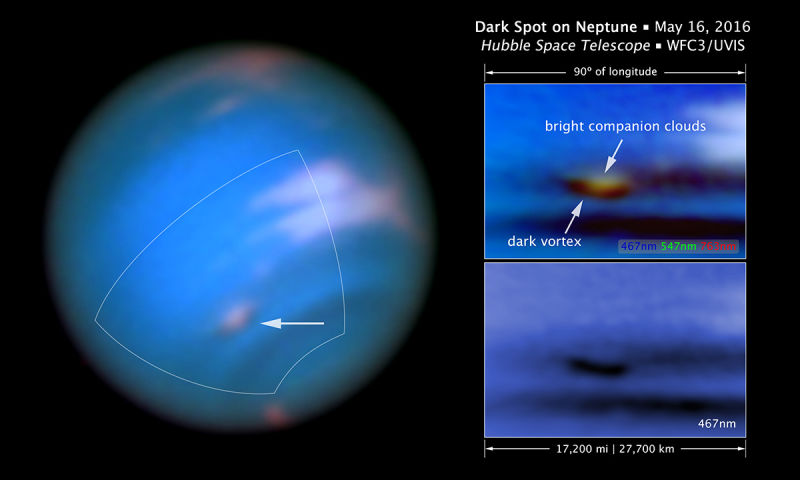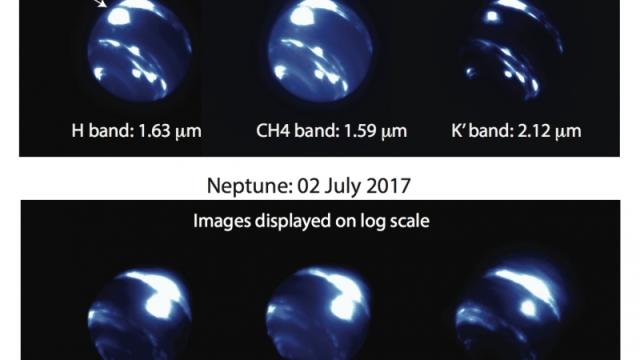Do not be alarmed, but a bright storm system three quarters the width of our entire planet has emerged over Neptune’s equator, in a region where no bright clouds have ever been witnessed before.
Images of Neptune taking during twilight at the Keck Observatory at Mauna Kea, between June 26th and July 2nd, 2017. Image Credit: N. MOLTER/I. DE PATER, UC BERKELEY/C. ALVAREZ, W. M. KECK OBSERVATORY
The “extremely surprising” observation was made by astronomers Ned Molter and Imke de Pater of the University of California Berkeley, during a test run observing Neptune at twilight at the W.M. Keck Observatory at Maunakea, Hawaii. The storm, which spans roughly 9000km, appeared to get “much brighter” between June 26 and July 2, according to a press release issued by Keck this week.
“Historically, very bright clouds have occasionally been seen on Neptune, but usually at latitudes closer to the poles, around 15 to 60 degrees north or south,” de Pater said in a statement. “Never before has a cloud been seen at, or so close to the equator, nor has one ever been this bright.”
A distant ice giant that’s only been visited by a single spacecraft, Voyager 2, the inner workings of Neptune remain largely mysterious to planetary scientists, although they have witnessed some impressive meteorological action in its azure skies over the years. The Hubble Space Telescope saw a similar bright cloud complex in 1994, shortly after a mysterious dark vortex, imaged by Voyager 2 in 1989, had disappeared.
In 2015, a new dark vortex cropped up in Neptune’s southern hemisphere. Scientists have been attempting to track the anti-cyclone ever since, snagging some beautiful images with Hubble last year. As UC Berkeley’s Mike Wong explained in a talk I attended at the American Geophysical Union annual meeting last December, dark spots “often have these bright companion features” which absorb strongly in the part of the spectrum associated with methane.

The dark vortex observed by Hubble in Neptune’s southern hemisphere last year. Image: NASA, ESA, and M.H. Wong and J. Tollefson
When I spoke with Wong after his talk, he told me his team was trying to figure out why the dark vortex was drifting to the south (“…it sorta threw us off — what we were looking for was for it to drift to the equator and dissipate”), whether it was indeed shrinking as preliminary data suggested, and how long the feature would last. His research group was also exploring models to elucidate what actually makes dark spots dark.
“The most exciting possibility is that this could indeed be associated with a dark vortex,” Wong said when I emailed him about the latest Neptune observations. “We can’t resolve enough detail to know, but this could be some type of wave activity associated with dark vortices. It would be great to image something like this with an extremely large telescope… or better yet, a Neptune orbiter!”
De Pater and Molter also suspect the bright clouds chilling near Neptune’s equator could be related to gases rising up and condensing out of a deeply-rooted dark vortex system. The clouds might also be an enormous convective system, similar to those seen on planets like Saturn.
“We were very surprised to learn that the storm was consistent with being right at the equator — it’s difficult to understand how a deep vortex could be sustained there, since the Coriolis force is zero,” Molter said in an email to Gizmodo. “It could be that the underlying vortex is a few degrees north or south of the equator, or that this cloud lacks an underlying vortex and will quickly shear apart.”
De Pater and Molter plan to continue investigating the colossal cloud complex — they’re hoping to secure more observing time at Keck this spring. Neptune is the windiest planet in the Solar System, and studying its complex weather can shed light on the inner workings of ice giants, a club that it shares with just one other planetary oddball, Uranus. (Unlike gas giants, which are composed mainly of hydrogen and helium, ice giants contain a larger share of heavier elements like oxygen, carbon and nitrogen. They may even harbour hidden liquid water oceans.)
“Discoveries like this one underline just how little we know about the atmospheres of the ice giants,” Molter said.
